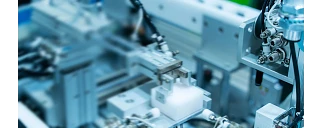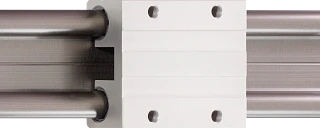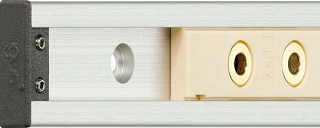Cambiar idioma :
¿Qué diferencia hay entre la tecnología lineal y los dispositivos de manipulación?
Por ejemplo, las guías lineales drylin® ayudan en la manipulación de sistemas como el NTS-Ultra-Speed de AS-Morawski.

Resumen de las ventajas de los sistemas de manipulación eléctricos:
- Diseño compacto y sencillo
- Funcionamiento limpio, silencioso y con ahorro de energía
- Sin pérdida de precisión de posicionamiento
- Menor masa en movimiento
- Alta velocidad de funcionamiento

Resumen de las ventajas de los sistemas de manipulación eléctricos:
- Diseño compacto y sencillo
- Funcionamiento limpio, silencioso y con ahorro de energía
- Menor masa en movimiento
- Alta velocidad de trabajo

¿Qué guía lineal en sistemas de manipulación?
Un diseño compacto, un funcionamiento sin mantenimiento ni averías, una construcción económica y una gran precisión son buenas razones para decantarse por un sistema de accionamiento eléctrico en la manipulación lineal frente a un dispositivo de manipulación neumático. Sin embargo, para poder aprovechar estas ventajas, también hay que responder a la pregunta de la técnica lineal que se va a utilizar en los ejes del pórtico. ¿Qué es lo que realmente importa al hablar del material y el diseño de las guías lineales y los carros?

Una cosa es cierta: el guiado desempeña un papel fundamental para que la precisión y la fiabilidad no se vean mermadas por los elevados tiempos de ciclo y las altas velocidades de trabajo.
AS-Morawski confía en las guías lineales deslizantes dela gama de productos "drylin®" para su NTS Ultra-Speed, ya que permiten sistemas de manipulación muy compactos y completamente exentos de mantenimiento. Además, con ellas se pueden realizar dispositivos de manipulación de cualquier longitud. Su precisión de posicionamiento es inferior a la de guías de precisión muy caras.

Sin embargo, el llamado sistema de ajuste de holgura "" garantiza un sistema de guiado sin holgura con precisiones de posicionamiento de +/- 0,1 mm.
En concreto, los sistemas de guías drylin® R, drylin® W, drylin® T y drylin® N se utilizan en los dispositivos de manipulación de AS-Morawski.
La característica más importante del diseño de los sistemas: A diferencia de los conocidos sistemas de recirculación de bolas, las guías lineales drylin® funcionan con elementos deslizantes especiales. Éstos están fabricados en su mayoría con el material iglidur® J, que presenta ventajas en la aplicación debido a sus propiedades especiales de desgaste y fricción.
Testimonios de clientes - ¿Qué dice el cliente?
"Basándonos en nuestros muchos años de experiencia, podemos confirmar que el igus®-guía es muy adecuado para la tecnología de manipulación. Como parte de nuestra gama de productos, las hemos utilizado y probado para todas las aplicaciones en ingeniería mecánica. En al menos el 75 por ciento de los casos, pueden sustituir a las guías de recirculación de bolas de acero. Cuando se trata de ser 100% libre de mantenimiento, drylin® no tiene rival."
Georg Morawski, Desarrollo y Dirección de AS-Morawski
Consultas
Estaré encantado de responder a sus preguntas personalmente

Borisenko Martin
Distribuidor
Escribir un correo electrónicoConsultas y envíos
En persona:
De lunes a viernes de 8:00 a 18:00h
Online:
24h




